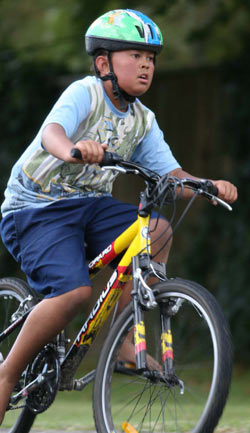Fitness Blog Covering Topics Of Interest
Monday, October 05 2015
The next time you have a check-up, don’t be surprised if your doctor hands you a prescription to walk. Yes, this simple activity that you’ve been doing since you were about a year old is now being touted as “the closest thing we have to a wonder drug,” in the words of Dr. Thomas Frieden, director of the Centers for Disease Control and Prevention.
Of course, you probably know that any physical activity, including walking, is a boon to your overall health. But walking in particular comes with a host of benefits. Here’s a list of five that may surprise you.
1. It counteracts the effects of weight-promoting genes. Harvard researchers looked at 32 obesity-promoting genes in over 12,000 people to determine how much these genes actually contribute to body weight. They then discovered that, among the study participants who walked briskly for about an hour a day, the effects of those genes were cut in half.
2. It helps tame a sweet tooth. A pair of studies from the University of Exeter found that a 15-minute walk can curb cravings for chocolate and even reduce the amount of chocolate you eat in stressful situations. And the latest research confirms that walking can reduce cravings and intake of a variety of sugary snacks.
3. It reduces the risk of developing breast cancer. Researchers already know that any kind of physical activity blunts the risk of breast cancer. But an American Cancer Society study that zeroed in on walking found that women who walked seven or more hours a week had a 14% lower risk of breast cancer than those who walked three hours or fewer per week. And walking provided this protection even for the women with breast cancer risk factors, such as being overweight or using supplemental hormones.
4. It eases joint pain. Several studies have found that walking reduces arthritis-related pain, and that walking five to six miles a week can even prevent arthritis from forming in the first place. Walking protects the joints — especially the knees and hips, which are most susceptible to osteoarthritis — by lubricating them and strengthening the muscles that support them.
5. It boosts immune function. Walking can help protect you during cold and flu season. A study of over 1,000 men and women found that those who walked at least 20 minutes a day, at least 5 days a week, had 43% fewer sick days than those who exercised once a week or less. And if they did get sick, it was for a shorter duration, and their symptoms were milder.
Thursday, July 16 2015
Mobility — the ability to move purposefully around your environment — is vitally important to health and well-being.
Nearly one-third to one-half of adults ages 65 and older experience impaired mobility. At first, it may not seem like a big deal — many people with impaired mobility learn to just move a little more slowly and a little more deliberately. Some people work around the problem by relying on a cane or walker.
That’s why it’s important to intervene to either prevent future mobility impairments or reduce existing ones.But taking impaired mobility “lying down” can cause your health to spiral downward. As you move less, pounds may start to creep on. You might withdraw from social relationships and activities that challenge you mentally. Exercise may become difficult, and lack of activity can worsen many health problems. This cycle of physical, emotional, and mental decline further restricts mobility.
For most people, the ability to rely on their own bodies, skills, and mental agility is a crucial part of living a satisfying life. Having full mobility helps you fully engage with the world and fosters a sense of self-sufficiency that can help you live independently well into your later years.
Saturday, February 15 2014
If you have diabetes — or for that matter, nearly any other chronic illness — exercise is one of the most powerful tools that can help you control your weight and blood sugar. And it can help you feel great, too.
The list of exercise benefits is long. Exercise helps control weight, lowers blood pressure, reduces harmful LDL cholesterol and triglycerides, raises healthy HDL cholesterol, strengthens muscles and bones, and reduces anxiety. Exercise can help regulate blood sugar and increase the body’s sensitivity to insulin. Both are important for people with diabetes.
Many studies have documented that exercise is a strong ally in treating diabetes. Here are a few examples:
- All forms of exercise — aerobic, resistance, and a combination of both — have been shown to be equally good at lowering HbA1c values.
- Resistance training and aerobic exercise both helped to lower insulin resistance in previously sedentary older adults at risk for diabetes. Combining the two was better than either one alone.
- People with diabetes who walked at least two hours a week were less likely to die of heart disease than their sedentary counterparts, and those who exercised three to four hours a week cut their risk even more.
- Women with diabetes who spent at least four hours a week doing moderate or vigorous exercise had a 40% lower risk of developing heart disease than those who didn’t exercise.
If you have diabetes, generally it is best to exercise one to three hours after eating, when your blood sugar level is likely to be higher. If you use insulin, be sure to test your blood sugar before exercising. If it is below 100 mg/dL, eat a piece of fruit or have a small snack. This will bump your blood sugar up and help you avoid hypoglycemia. Test again 30 minutes after your snack to be sure your blood sugar level is stable. It’s also a good idea to check your blood sugar after any particularly grueling workout or activity. If you’re taking insulin, your risk of developing hypoglycemia may be highest six to 12 hours after exercising. Experts also caution against exercising if your blood sugar is too high (over 250).
A medical alert bracelet should be part of your workout wardrobe. It should indicate that you have diabetes and whether you take insulin. Also, keep hard candy or glucose tablets with you while exercising in case your blood sugar takes a nosedive.
To learn more about how to live a healthy life with diabetes and ways to keep your blood sugar in check and avoid complications, contact Ronald @gyminmotion 07929 256856.
Wednesday, January 23 2013
Remember when a total cholesterol reading of under 200 was the standard for judging cardiovascular health? Today, of course, we know that it's the components of cholesterol (LDL, HDL, the size of those cholesterol particles, and triglycerides) that are much more predictive of heart health. Well, our understanding of total weight and its effects upon your heart has evolved in similar fashion. It's not your total weight but the characteristics of that weight—how much is fat and where it's deposited—that matter most.
Surprised? Thank the scientists at the Mayo Clinic, who are behind this recent discovery. After comparing various health markers with the weights and body mass index numbers of thousands of adults, they found that more than half of those with normal weights and BMIs actually had "high body-fat percentages as well as heart and metabolic disturbances." In other words, they had the same risks of coronary disease, diabetes, and other chronic illness as people who weighed much more.
This research, and its sobering implications for millions of Americans, led to the establishment of a new condition called normal weight obesity (NWO). This is more than just the latest fat phobia. It's worth paying attention to because the accumulation of fat in the body, especially in the belly and around internal organs, causes low-level inflammation that gradually damages tissue and blood vessels. (Think of it as metabolic rust.) So even though your weight or BMI may be within acceptable limits for your height and age, don't be lulled into a false sense of security. Do your own analysis, starting with these steps:
1. Stop being preoccupied with pounds. As with total cholesterol, total weight is just one general assessment of your health. Yes, people who are trying to lose weight are more likely to succeed if they weigh themselves often. But seeing numbers that are within a healthy BMI range may actually disguise your heart disease risk. Keep them in perspective.
2. Measure your body fat. For a quick estimate of this key factor, wrap a cloth measuring tape around your naked waist just above your belly button. If your weight is fairly normal but the number you see above your navel is 35 inches or more (40+ inches for men), you may have NWO. For a more exact reading, ask your doctor (or health club) to measure your body fat. This can be done using a variety of noninvasive methods. If it's higher than 30 percent (20 percent for men), you likely have NWO.
3. Get a blood test. Ask your doctor to order a thorough blood analysis at your next physical. Warning signs of NWO include low HDL (total cholesterol and LDL may be normal), along with elevated triglycerides, blood sugar, and blood pressure.
4. Target belly fat. If you're diagnosed with NWO, take aim at visceral fat. Despite how entrenched it may seem, you can lose it. The keys are: Avoid the white stuff (white bread, rice, pasta, and other refined carbohydrates). Add monounsaturated fats, which target belly fat, to your diet. And do interval exercises to burn more fat and strength-training to build lean body mass.
5. Keep tracking fat. Just as you hop on the scale to keep tabs on your weight, do the same with your body fat. Have it measured periodically at your doctor's office or health club. Or just observe the notches where your belt buckles.
Conversely, if you're considered overweight by current standards, there may be some good news here. If your body-fat percentage is lower than 30 percent (20 percent for men) and your blood chemistry is normal, then you are among the "fat and fit." (Many athletes are in this category.) Continue to eat smart and exercise, but accept your body for what it is and know you're not unhealthy because of it. Feeling fat and feeling healthy are no longer mutually exclusive.
More Heart-Healthy Advice
Staying hydrated is one simple way to keep blood pressure in the safe zone.
Wednesday, January 16 2013
Boston, MA – Men who do weight training regularly—for example, for 30 minutes per day, five days per week—may be able to reduce their risk of type 2 diabetes by up to 34%, according to a new study by Harvard School of Public Health (HSPH) and University of Southern Denmark researchers. And if they combine weight training and aerobic exercise, such as brisk walking or running, they may be able to reduce their risk even further—up to 59%.
This is the first study to examine the role of weight training in the prevention of type 2 diabetes. The results suggest that, because weight training appears to confer significant benefits independent of aerobic exercise, it can be a valuable alternative for people who have difficulty with the latter.
The study will be published online in Archives of Internal Medicine on August 6, 2012.
“Until now, previous studies have reported that aerobic exercise is of major importance for type 2 diabetes prevention,” said lead author Anders Grøntved, visiting researcher in the Department of Nutrition at HSPH and a doctoral student in exercise epidemiology at the University of Southern Denmark. “But many people have difficulty engaging in or adhering to aerobic exercise. These new results suggest that weight training, to a large extent, can serve as an alternative to aerobic exercise for type 2 diabetes prevention.”
Type 2 diabetes is a major public health concern and it’s on the rise. An estimated 346 million people worldwide have type 2 diabetes, and diabetes-related deaths are expected to double between 2005 and 2030, according to the World Health Organization. More than 80% of these deaths occur in low- and middle-income countries.
The researchers, including senior author Frank Hu, professor of nutrition and epidemiology at HSPH, followed 32,002 men from the Health Professionals Follow-up Study from 1990 to 2008. Information on how much time the men spent each week on weight training and aerobic exercise came from questionnaires they filled out every two years. The researchers adjusted for other types of physical activity, television viewing, alcohol and coffee intake, smoking, ethnicity, family history of diabetes, and a number of dietary factors. During the study period, there were 2,278 new cases of diabetes among the men followed.
The findings showed that even a modest amount of weight training may help reduce type 2 diabetes risk. The researchers categorized the men according to how much weight training they did per week—between 1 and 59 minutes, between 60 and 149 minutes, and at least 150 minutes—and found that the training reduced their type 2 diabetes risk by 12%, 25%, and 34%, respectively, compared with no weight training. Aerobic exercise is associated with significant benefits as well, the researchers found—it reduced the risk of type 2 diabetes by 7%, 31%, and 52%, respectively, for the three categories above.
The researchers also found that the combination of weight training and aerobic exercise confers the greatest benefits: Men who did more than 150 minutes of aerobics as well as at least 150 minutes of weight training per week had a 59% reduced risk of type 2 diabetes.
Grøntved said that further research is needed to confirm the results of the study as well as to analyze whether or not the findings can be generalized to women.
“This study provides clear evidence that weight training has beneficial effects on diabetes risk over and above aerobic exercise, which are likely to be mediated through increased muscle mass and improved insulin sensitivity,” said Hu. “To achieve the best results for diabetes prevention, resistance training can be incorporated with aerobic exercise.”
Other HSPH authors included Eric Rimm, associate professor in the Departments of Epidemiology and Nutrition, and Walter Willett, Frederick John Stare Professor of Epidemiology and Nutrition and chair of the Department of Nutrition.
Support for the study was provided by the National Institutes of Health (DK58845 and CA55075).
“A Prospective Study of Weight Training and Risk of Type 2 Diabetes Mellitus in Men,” Anders Grøntved, Eric B. Rimm, Walter C. Willett, Lars B. Andersen, Frank B. Hu, Archives of Internal Medicine, online August 6, 2012.
Tuesday, December 18 2012
About A.B.C.D.E.
Every child needs to learn the ABC’s of life. When it comes to establishing healthy habits, you can teach them how to “ABCDE” (Act Boldly to Change Diet and Exercise).
Why is this important?
-
Good nutrition and plenty of exercise are the building blocks for strong growth, healthy development, and lifelong wellbeing for children.
-
These days, too many children are not receiving the proper nutrition or enough exercise:
-
- They are not eating enough - an estimated 16 to 17 million children live in homes where they are at risk of going hungry (approx. 1 in 6 households).
-
- They are not eating enough healthy food – an estimated 1 in 3 children are overweight and about 1 in 6 (ages 6-17) are obese.
-
- They are not getting enough exercise – only 30% of children (aged 6 to 17) participated in 20 minutes plus of vigorous physical activity on a daily basis. Children need to get 60 minutes of exercise on a daily basis.
What are the benefits of good nutrition and daily exercise for kids?
Mental and behavioral benefits
-
Good nutrition is essential to healthy brain development in children which is, of course, critical to learning.
-
Children who exercise regularly and eat healthily are likely to:
-
- perform better academically
-
- feel better about themselves, their bodies, and their abilities
-
- cope with stress and regulate their emotions better
-
- avoid feelings of low self-esteem, anxiety, and depression.
-
Establishing healthy eating and exercise habits early in life can lead to long term healthy behavior in adulthood.
Physical benefits
-
Children need a wide variety of nutrients (e.g., protein, complex carbohydrates, healthy fats, minerals, vitamins) to assist in their daily growth and development and to protect them from childhood illnesses.
-
Daily exercise also helps children to build stronger muscles and bones and limit excess body fat.
-
Healthy eating also cuts down on risk for cavities, eating disorders and unhealthy weight control behaviors (i.e., fasting, skipping meals, eating very little food, vomiting, using diet pills, laxatives, or diuretics), malnutrition, and iron deficiency.
-
Healthy eating and consistent physical activity help to prevent chronic illnesses that appear in adulthood associated with obesity, e.g., heart disease, diabetes, high blood pressure, and several forms of cancer.
What are the effects of different settings on the eating and exercise habits of kids?
In the home:
-
Lack of access to healthy, wholesome foods and inadequate physical activity - contributes to kids becoming overweight and not getting adequate nutrition for their growth and development. Children need at least 60 minutes of daily physical activity in the form of physical play or sports.
-
Hunger – kids who do not get enough to eat are at risk of developing chronic health conditions, behavioral problems, academic struggles, anxiety, depression, and even obesity especially if they only have access to poor quality processed food.
-
Unhealthy weight control behaviors - have been found to co-occur with obesity. Many adolescents, particularly teenage girls, have body image concerns and engage in these behaviors threatening both their physical and mental health.
-
Media effects –
-
- Food advertising - targeted at children is dominated by commercials for unhealthy food (e.g., candy, sugary cereals, sugary beverages, processed snack foods, fast food restaurants). Food advertising is pervasive and can be found on multiple media platforms (TV, web, and even embedded in computer games).
-
- Advertising by other industries - often objectifies girls and women, contributing to body dissatisfaction, eating disorders, low self-esteem, and depression.
-
- TV watching – television viewing is linked to childhood obesity because it displaces physical activity, increases snacking behavior while watching, exposes kids to potentially harmful advertising, and reduces their resting metabolism.
At school:
-
Risks to academic achievement - result from children not getting adequate nutrition and physical activity. Hunger can be particularly damaging to children’s progress in school and cognitive development overall.
-
Overabundance of unhealthy foods - too many schools offer poor nutritional choices in the form of unhealthy school lunches or even vending machines filled with candy, processed snacks, and sugary beverages.
-
Lack of opportunities for physical activity - many schools have scaled back requirements for a daily recess and do not prioritize physical education opportunities for children at every age.
-
Peer behaviors – peers can serve as remarkably powerful role models for children and may share their unhealthy eating or exercise habits with them.
-
Stigma of being overweight – can lead to social and psychological distress (e.g., depression, low self esteem). Bullying and teasing from peers can be particularly damaging and teachers and school staff may attribute less desirable personality characteristics to obese youth and their families.
In the neighborhood:
-
Overabundance of unhealthy foods – there are a growing number of communities called “food deserts” where supermarkets and grocery stores are scarce or charge higher prices for healthy foods than processed foods. In addition, many underserved communities are populated with fast food restaurants that are often located near schools and playgrounds.
-
The built environment – lack of adequate and safe parks, bike lanes, playgrounds, recreational facilities, or walkways can restrict opportunities for children and teens to get exercise.
Why are you critical to establishing healthy behaviors in your kids?
-
You are role models
-
You are gatekeepers
-
- Parents and caregivers control the types of food children have access to in the home and can maximize access to healthy, wholesome foods (fruits, vegetables, lean proteins, whole grains, and low-fat dairy).
-
- You can also monitor children’s diet, exercise, and limit media consumption (TV/video watching, web surfing, and videogames).
-
You are taste-setters
-
- Parents and caregivers significantly influence the likes and dislikes that children attach to certain foods. These influences can last a lifetime. Each of us can probably remember a favorite home cooked meal from our childhood. There is even research that suggests that this begins in infancy; children who are breastfed may be exposed to different flavors in their mother’s breast milk than the sugars and fats in infant formula. Breastfeeding may provide protection from the development of obesity.
-
- Eating with your children at regular family mealtimes can help establish positive nutrition habits and healthy weights for children.
-
You are advocates
-
- Parents and caregivers can push local leaders to introduce affordable transportation (e.g., bus or shuttle lines) to supermarkets or grocery stores if there are none in their communities.
-
- You can call for the construction of parks or playgrounds and restriction of fast food places in your neighborhood.
-
- You can push school administrators to introduce after-school programs that incorporate physical activity or nutrition education, healthier school lunches, and policies that eliminate the use of vending machines on school grounds.
-
- You along with members of your community can volunteer to coach afterschool sports.
Monday, November 12 2012
The story of a four-year-old boy in India who has been running distances of up to 60 kilometers has led to a lot of discussions, including among the Take The Magic Step® team. We spoke to Dr. Henning Ohlert about appropriate exercise for young children, as well as about some strategies for parents to deal with this issue.
Dr. Ohlert, 46, is a lecturer of training science at the University of Potsdam. He was a professional athlete for ten years, and as a 23-year-old ran the 800 meters in 1:45.9. He is working on a long-term study of motor skills and development of ten-year-old children.
 © Betty Shepherd
© Betty Shepherd
How much exercise can a child cope with?
Over the years, our attitude towards children’s capabilities has changed tremendously. Basically, you could say that children are “little champions of endurance.” The big advantage of children is that they stop what they are doing automatically when they feel that they are getting tired and reach their physical limits. If children are tired out during playing, they simply take a break, and once they have recovered, they get active again. I think that you cannot do anything wrong with children-you just cannot challenge them physically in the wrong way. They know how to adjust themselves, and will utter their disapproval when it gets too much for them. And this disapproval should be respected.
What you have to watch out for with children, however, is problems with their thermoregulation; that is, the loss of body warmth during physical activity. Children get red faces when they are playing, bouncing around or playing sports. The body warmth which develops causes fast panting while breathing. The reason for this is that their perspiration system with does not function as that of an adult yet. That’s why you have to be careful to prevent children from overheating. In general, however, children have quite a sensitive feeling for the right proportion of activity and rest. It is highly dangerous, though, what is demanded of the little boy in India.
How can parents tell what and how much they can expect and ask from their children?
I believe you can ask more from children than most parents would think. You can judge by certain subjective criteria if a physical activity is enough: the color of the skin (for example, if the paleness of the skin is extreme), the frequency of the breath, the heart rate as well as the quality of movements. You will realize pretty quickly that movements seem to become uncontrolled and the way children fall changes. These are clear indications for the necessity of a break.
 © Betty Shepherd
© Betty ShepherdAt what age should children start to train on a regular basis?
In order to answer this question, you would have to define the term “systemically organized training” first. I think that until a child has reached the age of eight, we shouldn’t call it training. There is nothing wrong with daily exercise or physical activities. Children should be active in various non-specific ways and thereby gain a broad range of experiences. This is the best prerequisite for successful involvement in sports later on.
Is there such a thing as unathletic children?
In my opinion, there is no such thing as unsporty kids. At times someone gets called “unathletic” just because he is judged by certain skills and abilities. It is just normal, however, that you are not able to do things which you have never done or practiced before. Often you get also judged by your family background. But just because your parents consider themselves unathletic, it does not necessarily have to mean that the son or daughter is as well. Every child is athletic. The question is only if she is athletic enough to become a champion.
Don’t children have a natural urge to move?
Absolutely. Unfortunately, this urge is lost throughout the ontogenetic development. At puberty, this urge to move decreases. This is when young athletes often lose interest in their sport and don’t show up for training anymore.
Should parents try to intervene?
It would not be good if the enthusiasm for the sport got completely lost. It is normal and should be tolerated that there are phases of less motivation. You should still try to talk to your child, his or her coach and friends about the situation, options and possible wasted opportunities.
Children tend to change their enthusiasm for different things quite quickly. Today they are playing tennis, tomorrow they want to become a professional swimmer, the day after tomorrow a famous basketball player. Sometimes they are not sure at all. Should children do several kinds of sport or should they better concentrate on one?
I strongly recommend that children experience a rather broad range of physical activities. I assume that not every child should be trained to become a Davis Cup player. Instead, most children will just want to play tennis for fun, or they just want to go inline skating, running or play soccer. I am a great supporter of children practicing a variety of sports.
Is it naive to believe that children will be grateful one day if parents put some pressure on them and force them to keep up a certain sport, hoping that they will be successful and the sport turns out to be the right one for the child?
This wish or hope might be honorable, but children think differently. Children think very emotionally, and are not as rational as adults are. The reasons why children give up on something are not easily understood. A little bit of pressure might not be wrong. It is a great achievement, however, if children discover themselves what they like.
Should parents tell their children which expectations they have regarding their sporting performance?
Parents’ expectations should not put too much negative pressure on the children. There is a lot of evidence in pedagogy that children fail just because their parents were asking too much of them. Children often act paralyzed if they are put under too much pressure. Then they are often criticized for failing mentally, but no one realizes how much pressure has been put on them: “You have to do this, you have to do that!”
Parents have to learn to judge their children’s mental condition and figure out how they can teach them ambition and determination. As a matter of fact, a runner participates in a race to get to the finish line among the best and not far behind the first ones. Consequently, you can, of course, tell your children that sport is often about being better and faster than others. This should be done sensibly, however, and without any pressure. It is nearly impossible to get children’s enthusiasm back if you have put them off doing sports once and if sports have become a trauma for them. This is proven by scientific research. The next chance you get to convince them of doing sports again is when they have grown up and when stress at work and an unhealthy diet have caused health problems and the cardiologist tells them, “You have to get moving, you have to exercise!”
 © Betty Shepherd
© Betty Shepherd
On the other hand, children are often highly motivated when their parents watch them at training or competitions.
It is obvious that children are extremely motivated when they realize that their parents fully support what they are doing. At some stage, however, their own motivation will become so high that they don’t need their mother’s or father’s support anymore. But even professional athletes are more motivated when their parents are in the stadium or along the race course, no matter if in tennis, soccer or running. The question is just how parents react to their children’s failure. It is important that you find out together-maybe even with the coach-where mistakes might have been made and how you could adapt the training. Children have to feel that you support them and don’t give up on them.
What should parents do if their child suddenly, after two years, does not like judo anymore and would rather want to do athletics or tennis? Should parents demand that their children continue doing what they have started to do and not to give up on something just because it is no fun at the time?
I don’t find it too bad to change from one kind of sport to the other. You should have a conversation and clarify why they don’t like the sport they used to do anymore. There are certainly understandable reasons for it. And if they are not understandable, you still should not act against your child’s wish.
What should parents do if they recognize sporting talent in their child, but are not sure if they want to support it?
If someone thinks his child has got talent in some area which is illustrated by being better at something than other children of the same age, I would recommend approaching a sporting club close by and asking if there are facilities to support this talent specifically. I don’t find it very good to place children in “talent factories” far away from home where they waste a lot of time traveling to and from the place. Children should be able to pursue their training without many hassles. If they further develop and prove their talent, there are more opportunities of support in young adulthood, such as elite sporting schools or scholarships.
And vice versa: How are mothers and fathers to act if children desperately want to become professional athletes, but just seem to lack the talent?
I would still give the child the same chances, as eventually the “moment of truth” will show if the child is as good as she thinks she is. In cases of constant failure, however, you should be honest with your child, and tell him that another kind of sport might be more suitable for him. There are a lot of children who change to another kind of sport after the advice of a friend or parents and who have become really successful at it. Children who are motivated and ambitious should initially do what they prefer and should try things out.
If parents for some reason think that they should apply sanctions against their child-maybe because of bad marks at school-are prohibiting going to training and doing sports reasonable disciplinary measures?
I find prohibiting sports as punishment pedagogically not wise. Children have a natural urge to move and to play in order to cope with stress and emotions, and you cannot just switch this behavioral pattern off. If they are aggressive at school, they will be aggressive at sports, too. But particularly here, those negative emotions can be turned around into positive ones-through the pure movement, through the contact with the coach, through the group dynamics in team sports where bonding and camaraderie are crucial.
Sunday, October 14 2012

Trampoline Boy © Betty Shepherd
Our children are our future—and understanding and supporting their natural yearning for physical activity will help lead them to a lifetime of happy and healthy living. If we joyfully teach them how to include healthy exercise from the early stages of their development, we will be giving our children a gift that will endure throughout their lives.
Among the many benefits are physical fitness, confidence and stronger self-esteem, more energy, better memory, and simply a good feeling about themselves—and they are easy to achieve. Our Take The Magic Step® team is as concerned as many of you about the growing problem of childhood obesity and the lack of exercise in their lives. Whether this obesity and inactivity is caused by the popularity of video games or the declining hours of physical education in schools, it is a wake-up call for everyone. Happily, there are ways of reversing this growing trend and helping our children to enjoy daily exercise and outdoor activities, which they love given the opportunity.
Our “Children’s Fitness and Health Program” is geared towards parents and educators, and focuses on creative ways to incorporate exercise into our children’s everyday routine. Outdoor games and playful workout routines can be the tools that instill lasting joy of exercise. I was so lucky that I was introduced to, enjoyed and benefitted from these activities during my childhood. It created in me an appreciation and understanding of the complex benefits that fitness and exercise can add to a person’s wellbeing. Over the years I’ve been fortunate to share this lasting experience with many children and young adults. (I hope you find additional information in the “Families” section of this Web site).
To emphasize once again the importance of exercise, I have put together some of the health benefits an active child can expect.
Exercise Improves Physical Health
Long-term health benefits of exercise are:
- A stronger immune system! The body’s ability to fight disease is improved. Children are less prone to colds, allergies, and diseases, including cancer.
- A reduction of type 2 diabetes by increasing insulin sensitivity and improving carbohydrate metabolism.
- A lower blood pressure and an improvement of the child’s cholesterol profile.
- A strengthening of the entire cardiovascular system, including the heart and lungs. The heart develops a higher “pump-activity” while the child’s heart and lungs are strengthened, supporting the prevention of heart disease.
- Children are less likely to become overweight and will have better control of their body fat. Overweight children are able to reduce their body weight and body fat due to the physiological effect of burning fat while exercising.
- Children develop stronger bone structure and muscle structure.
Active children enjoy additional health benefits, because:
- Exercise increases the blood flow to all body tissues, including the brain. Greater blood flow transports more oxygen and nutrients to the body’s cells.
- Active children improve their body’s ability to absorb oxygen through aerobic exercise. Due to the increased oxygen in their body’s cells they feel more energized. More oxygen translates into more energy!
- Increased blood flow promotes the body’s transportation of the byproducts of metabolism and toxins back from the cells for elimination, recycling, or further use elsewhere. Children who exercise feel fitter and more energized because of their body’s ability to detoxify.
- Active children breathe better and sweat more. Breathing and sweating are great ways to detoxify the body and help it keep itself “clean.”
- Children increase their over-all fitness through exercise(1).
Exercise Improves Mental Health
 © Betty Shepherd
© Betty Shepherd
- Exercise enhances the brain’s metabolism. Studies show that active children have improved memory as a result of better brain function!
- Moderate, fun-oriented exercise literally burns off excess harmful hormones and, at the same time, increases the release of beneficial ones. One of the beneficial hormones acts as neurotransmitter for establishing new memories.
- Active children have the ability to concentrate much better, even at the end of a long school day.
- Studies report that exercise decreases anxiety, reduces depression, and improves mood and outlook in children. In addition, their quality of sleep is improved.
Perhaps most importantly, physical activity develops children’s self-esteem and confidence. Their ability to overcome difficult situations improves and they simply enjoy a better, sunnier outlook on life.
To parents and educators: Your efforts to encourage our children to exercise more and instill in them the wisdom of good nutrition and a healthy lifestyle will yield years of dividends in these young people’s lives. (… and the benefits mentioned are for adults too.)
To YOU CHILDREN: I wish you enjoyment of all your outdoor activities, your exercise, and your school! We are always with you!

Reference:
(1) Gavin ML (Medical Editor, KidsHealth.org), Dowshen SA (Chief Medical Editor, KidsHealth.org), and Izenberg N (Editor-in-Chief and Founder, KidsHealth.org): Fit KIDS. 1st edition, DK Publishing, Inc., New York, NY 2004.
Updated April 1, 2011
Copyright © 2006-2012 Uta Pippig
Saturday, July 28 2012

When you decide on your favorite summer workouts—we discussed a few fun options in Part I—you can move on to organize everything so you stay healthy and well-hydrated during your fitness routine.
First of all, add extra care to how you prepare for your workouts. Make sure you are properly hydrated beforehand. Drink small amounts of water frequently, beginning two hours before you go out. I would not necessarily drink too much for 20 to 30 minutes prior to your start, though, because it can make you need to “go” while working out.
If you plan to work out for more than one hour, you might want to run with a water bottle belt, as many athletes do. You also could leave one or more water bottles on the course. If you decide on that strategy, it is best to stay on a loop course. This gives you a chance to replenish every few miles. And, if you want to be absolutely safe, ask a friend to join you on a bike. For bikers, use both your water bottles, and stay ahead of the game by stopping at any convenience store or gasoline station to fill-up your bottles before you need them again.
Listen to Your Body, Stay Healthy
Nothing is more important than listening to your body. If you do not feel well, please be very cautious. Before, during, and after your workouts, the first signs of a possible problem might be heavier breathing, an elevated heart rate, or losing concentration. Consider wearing a heart rate monitor—it can caution you before you run into trouble.
When you feel unwell, admit it to yourself early on and get out of the heat right away. Cool off with a cold towel, use ice cubes, and hydrate! Please, do not wait to see a physician if you do not feel better immediately. Be familiar with some of the early warning signs of overheating: dizziness, fainting, fatigue, hot skin and followed by chills, lack of perspiration, feeling thirsty, and elevated heart rate. If you stop sweating, you most likely are very dehydrated(1).
Also be careful after your workout. Take a dry shirt to put on after your run, and always take some fluid to drink. If you feel cold—even in summer, for example when you come from outside into an air-conditioned room while still wearing your wet workout clothes—change immediately into dry clothes. It may be summer, but you need to stay “warm” after your workouts to avoid weakening your immune system and maybe getting a cold.
For adequate protection, sunscreen, glasses, a summer hat, and a rain jacket are always good to have close by.
Hydrate Well Throughout the Day
 © Betty Shepherd
© Betty Shepherd
It can be very warm and dry during the summer, so make sure you stay cool and hydrated at all times. There are some guidelines I would suggest, and one of my favorite is to keep a bottle of water or a sports drink close by. This will remind you to drink and get replenished with small amounts continuously and evenly spread out throughout the day.
Hydration is critical for many body functions, such as digestion, regulation of body temperature, and the circulatory processes that bring nutrients to the cells and transport waste from them. This is even more understandable when considering that our bodies are up to 75% water in total, depending on age and build, with blood being 83% water and the brain being 75 to 78% water. These are the levels when each of those organs work best(2).
When you get dehydrated, every cell in your body suffers, causing you to feel less fit and fatigued(3). This puts more stress on your body and makes you more prone to illness and disease. And you can be at risk of overheating, which can have terribly serious consequences—including being life-threatening.
For proper hydration, start with juice from a fresh squeezed lemon with lots of water first thing in the morning. It is good for re-hydration after your night’s sleep and also will help your body to detoxify.
And as mentioned earlier, drink enough before, if possible during, and right after your training. It is best to replenish within 30 minutes of finishing your workout—the so-called “recovery window.” I like to eat a big slice of water melon right after my training, it is a great source of water, antioxidants, and easily digested carbohydrates. In the following article “General Guidelines,” you can find more information on this topic.
A Few Thoughts on Summer Nutrition
 © Betty Shepherd
© Betty Shepherd
Many people like to adjust their nutrition and take advantage of everything that is fresh and more available in the summer, like tasty fruits and vegetables. It is berry season—maybe you are lucky enough to be able to pick your own on a berry farm. Eat food that has high water content like melon, citrus fruits, berries, and vegetables.
Diluted fruit juices with 1 part juice and up to 2 parts water can help you to stay hydrated. The juice from sour cherries, for example, has many health benefits and can even support faster strength recovery for runners.
You also can try the many different kinds of unsweetened iced teas. My favorite flavor is mango.
Enjoy what you eat and make it tasty. Add some cool summer nutrition like different kinds of smoothies. Depending on the amount you make, they even can be served as an entire meal. Just add water, berries (like raspberries and blueberries), banana, whey protein, and some ice cubes into a blender. Mix it and enjoy. Or try a variation with mango or pineapple. And for more health benefits, add a teaspoon of ground flaxseeds.
There also are many delicious salad creations with great dressings. You could try a variety of citrus dressings. Other choices of salads include my favorites—fresh cucumber salad with dill and onions or a tomato salad with olives, feta, and basil.
Sashimi and sushi can be delightful lighter dinner fare when well-portioned. And when you prepare your meals, add more vegetables than pasta or potatoes. And how about cold summer soups like water cress and gazpacho?
And for all you BBQ lovers, here are some thoughts on “Healthier Grilling.” I hope you can enjoy many relaxing summer evenings with your family and friends.
Good luck for your summertime fitness!

Please Spread Our News With Others
|













